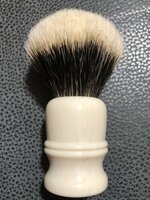- Thread starter
- #21
What does it do? What do you have to do to turn it?
Very nice and very dense looking.
For starters the specific gravity is 1.2! Janka hardness of 3670, it has a feel on the cutting tools that's much different from even other extremely hard woods I've turned; almost brittle (though it comes away in thin ribbons when drilling the knot hole, rather than dust), I tried to do detail shaping with a bowl gouge, but it pulled, chattered and skipped like crazy (yes, it was sharp), so I had to switch off to a carbide disc chisel.
Some sources recommend turning it with metal cutting bits.
It also caused a bit of irritation on my skin (long sleeves, safety glasses and respirator were worn), despite not being noticeably dusty (mostly fell away from the tools in tiny flakes), this one is probably best worked with a dust collector running.
If anything, this wood is *more* water repellant than Lignum!

